Troubleshooting a Car That Won’t Start
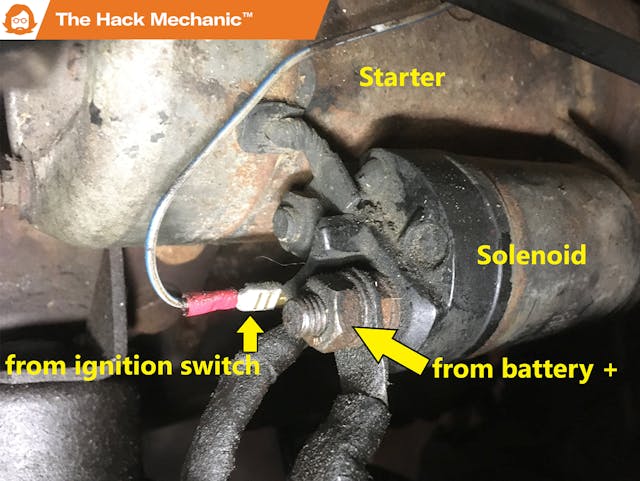
One of the topics I get asked about and over is the “My car won’t start” question. At this point in my life, I have my family pretty well programmed to not say “it won’t start” and to instead give the much more descriptive “it won’t crank” or “it cranks but it won’t start,” as such information is absolutely key to a diagnosis, particularly a remote one. I thought that, on this cold New England winter day, I’d lay out the basic car-won’t-start troubleshooting procedure.
A car needs three things to start: The battery needs to spin the starter motor, the fuel/air mixture must get sucked into the engine, and the spark plugs need to fire. Yes, the engine also needs compression and the ignition has to be timed at least in the ball park, but if the car was starting yesterday and it’s not today, the odds are it’s not due to those last two.
Let’s begin with the battery and the starter motor. The starter has two components—the starter motor itself, and the solenoid, which is an electrical relay that allows you to crank the engine without sending hundreds of amps through the steering column and ignition switch. The solenoid also has a little plunger inside it with a gear at the end that connects the starter to the gear on the outer edge of the flywheel, causing the engine to spin. For electrical connections, the solenoid has a long fat cable that’s directly connected to the positive battery terminal, and a short braided cable connected to the starter motor. The starter/solenoid are grounded by the fact that they’re mounted directly to the grounded engine, either directly to the negative battery terminal or indirectly via chassis ground. When the solenoid receives 12V from the ignition switch, it closes its internal contacts, allowing current to flow through the short braided cable to the starter motor and spin the engine. So if turning the key doesn’t spin the engine, the fault is either in the battery, the starter, the solenoid, the ignition switch, or the wiring between the switch and the solenoid.
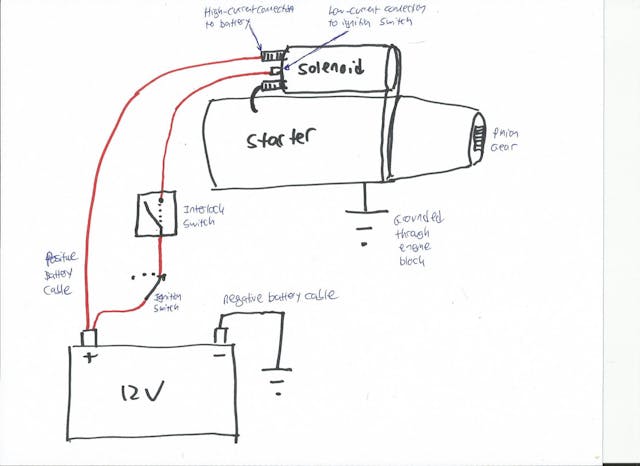
By far the most common cause for the starter not spinning the engine, or spinning it too slowly for it to start, is a weak or dead battery. If you turn the key and hear CLICK but there’s little or no engine cranking, that means the battery has enough charge to energize the solenoid, close its internal contacts, and move the plunger/gear moving forward, but not enough for the starter to spin the engine.
The first thing to do is check the battery voltage. Take a multimeter set to measure voltage (and if you don’t own a multimeter, just go buy one; auto-ranging meters can be had for $20 on Amazon), put the red and black leads across the positive and negative battery terminals and see if it reads the 12.6 volts that a fully-charged battery should have. As a rough rule of thumb, for every 0.2 volts the battery drops, the charge is down 25 percent, so by the time it’s under 12 volts, it’s essentially discharged, at least as far as the ability to spin the engine quickly. And if it’s down into the single volts, it’s deeply discharged. Now, it is possible for a just-recharged battery to read 12.6 volts and not be able to deliver sufficient cranking amps to spin the engine, but the best way to think about checking battery voltage is that if you find it’s low, you’ve found the source of the car-won’t-start problem.
If the battery voltage is fine but you turn the key and hear absolutely nothing, or hear one click and then nothing, and if none of the electrical systems in the car are working at all or are barely working (if, for example, the dome light is dim), the problem could be that the battery posts and the clamps at the ends of the battery cables are corroded enough to prevent good contact from being made. So before you pony up the $150+ it takes these days to buy a new battery, clean the posts and clamps with a battery post cleaner and try again. Also be certain to check the ground connections from the negative battery terminal to both the engine block and chassis. If one of these ground connections fails, electricity is forced to take the path through the other one, which can cause a no-crank condition.
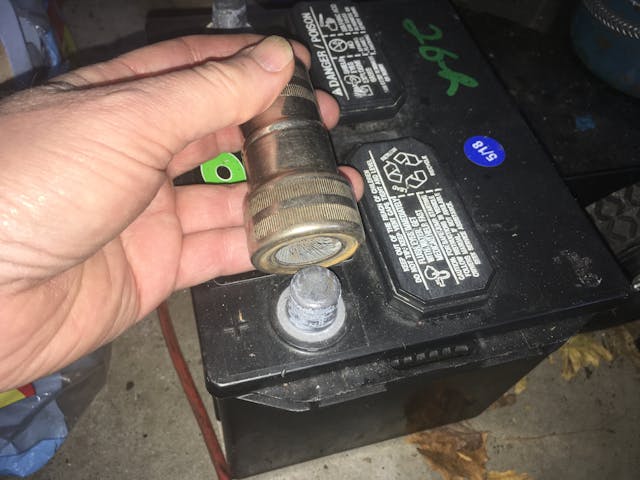
If the posts are clean and the ground paths are good but even once the battery is recharged it still won’t crank the car, or only does so for a short amount of time, you can use a battery analyzer that use resistance as a measure of battery health. I’ve found they work pretty well. But really the gold-standard test is to remove the old battery, clean the clamps, and install a new or a known-good battery. If the car then cranks and starts, the battery was the problem. Note that, particularly in winter, due to low temperatures sapping battery strength and corrosion on the battery terminals causing high resistance in the contact with the jaws on the jumper cables, the failure of a car to crank with a jump-start can be highly misleading. Time after time I’ve experienced no-crank conditions that vanished immediately when a good battery was dropped directly into the car.
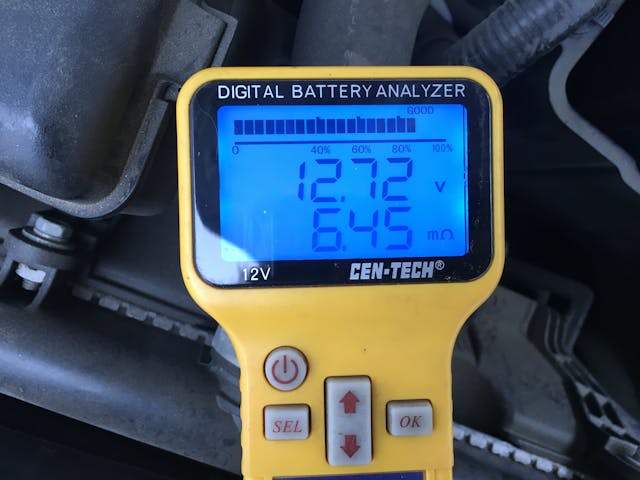
If the battery is dead, it’s crucially important that you figure out why it’s dead. If it’s winter, the battery is five years old, and the terminals are a corroded mess, then odds are that the battery has simply reached the end of its useful life. But if the battery is recent and it keeps running down to the point where it won’t crank the engine, something is making that happen. The cause can be that the car’s charging system (the alternator and voltage regulator and the wiring connecting them to the battery) isn’t working. As I say over and over, the resting voltage of a car battery is 12.6V, but with the engine running, it should increase by about 1–1.5V to between about 13.5–14.2V. So if you start the car, check the battery voltage, and still see 12.6V, the battery isn’t being recharged while you drive, so it will die on you again.
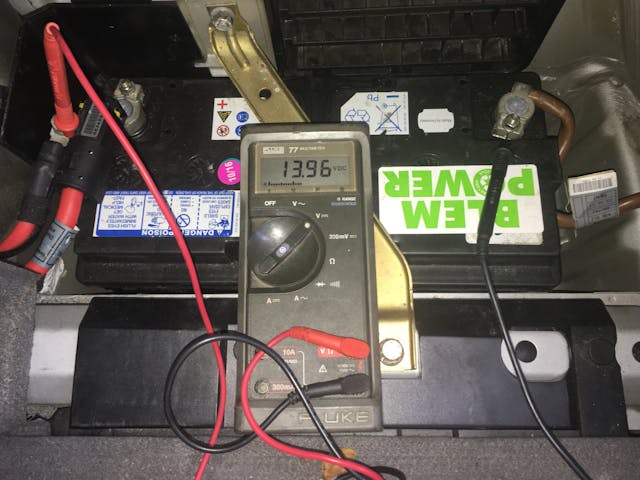
Other things causing a battery to drain can be that you’re leaving something on without knowing it, such as a trunk light or a power antenna. Or it can be a so-called parasitic drain where something subtle in the car is sucking power. Parasitic drains can be maddening. If the problem rears its head when the car hasn’t been driven for a week, sometimes the easiest thing is simply to install a battery disconnect switch, flip it off when you park the car in your driveway, and flip it on when you need to use the car.
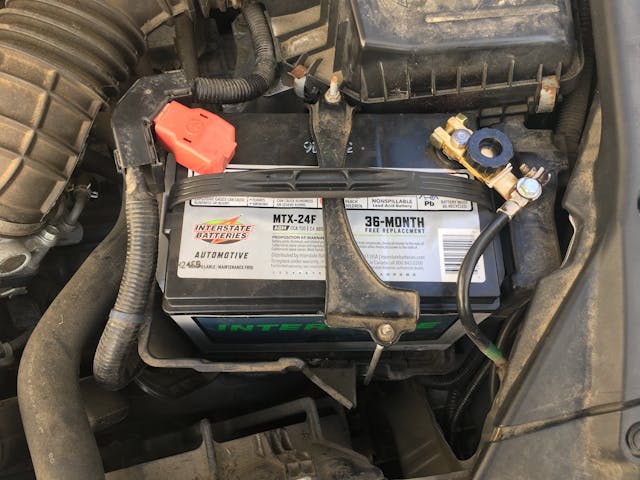
If you know beyond a shadow of a doubt that the battery and its connections are good and you hear no CLICK when you turn the key, odds are that the solenoid isn’t receiving voltage from the ignition switch. You can trouble-shoot this in two ways. You can use a multimeter to check for voltage on the quick-connect tab of the solenoid when the key is turned to the crank position. If there’s not voltage there, the ignition switch, or the wiring between it and the solenoid, is suspect. If the car has an automatic transmission, there may be a problem in the lock-out switch that allows the engine to be cranked only if the selector is in the park position.
The other way to check the solenoid is to make a jumper wire with a quick-connect connector on one end, slide it onto the tab on the solenoid, and—after you set the handbrake and make sure the car isn’t in gear—touch the other end to battery positive. If that doesn’t cause the solenoid to click, then either the solenoid is bad or there’s not a ground path between the solenoid and the battery. If the solenoid clicks but the starter doesn’t spin, then either the starter is bad or the positive and negative current paths are corroded. Note that bypassing the ignition like this and feeding 12V directly to the solenoid is exactly what you’re doing when you use one of those trigger-style remote starter switches. Note also that there’s an old-school technique where, instead of using a jumper wire, you take a long screwdriver, touch the tip to the starter’s heavy-duty positive post, and lean it against the solenoid terminal to fire it. I strongly advise not doing this, as it’s way too easy for the screwdriver to slip and short to ground. A jumper wire accomplishes the same thing and is much safer.

If you’re certain that the battery and the current paths are good, and the starter won’t spin or sounds labored, and it’s hot to the touch, odds are that the starter has reached the end of the line. Once you have the starter out of the car, you can test it just to be certain by using jumper cables to connect the fat positive post and any convenient point on the case to a battery, and touching the post on the solenoid to battery positive. Make sure, though, to stand on it, as when it starts to spin, it’ll jump around.
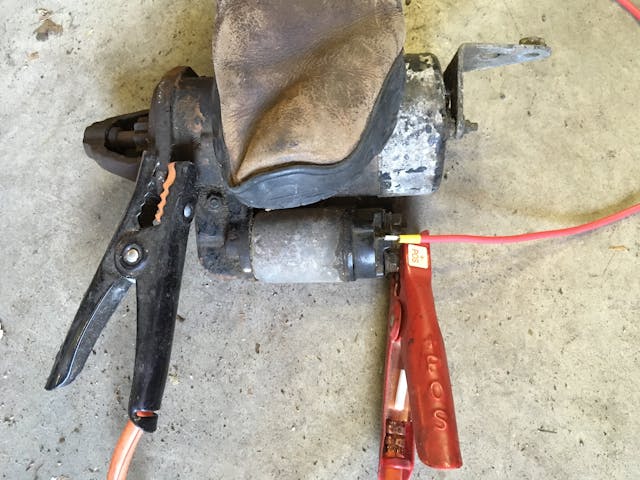
Now that you have the engine cranking, if the car still doesn’t start, you have to deal with fuel and spark. While it’s possible for an engine to have both fuel and spark and still not start, odds are strong that a crank-but-no-start condition is caused by one of them. Let’s deal with spark first.
On an old-school vintage car with a single ignition coil feeding a distributor and plug wires going to the spark plugs at each cylinder, it’s a simple matter to pull the center wire out of the distributor cap, hold it ¼-inch from ground with insulated pliers, and have someone crank the engine while you check for spark. If you see it, then the coil is firing and high voltage is going to the distributor. Do the same test with a plug wire. If there’s spark going into the distributor but none reaching the spark plugs, the problem is in the cap or the rotor. If there’s no spark at all from the coil, odds are that the points have closed up, the condenser isn’t grounded, or one of the wires has come off the coil. There’s really not much to vintage ignition systems, and no-spark problems can always be solved via replacement of components with known-good ones. Suspect the points and the connections first, then the condenser, and the coil last.
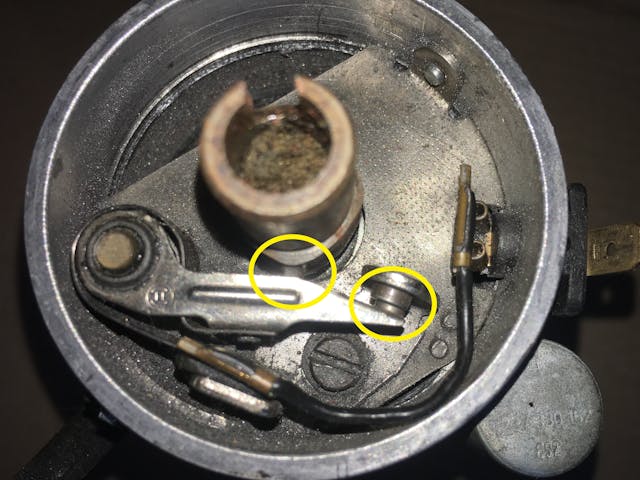
On modern cars, it’s much more difficult to directly check for spark. Instead of having a single ignition coil feeding a distributor with exposed plug wires, most cars since the mid-1990s have had a coil-on-plug design (also called “stick coils”) where individual coils sit directly on top of the spark plugs in a recess in the head, so there’s no easy way to directly verify spark. While any number of things can cause a no-spark condition, a likely suspect is the crankshaft position sensor, as without that fiducial, the car’s ECU doesn’t know when to fire the plugs. If it goes bad, hopefully it’ll throw a code that can be read with a scan tool.
If you have spark but the car still won’t start, odds are it’s a fuel delivery issue. A quick and easy test is to take a can of starting fluid and give a blast down the throat of the carb with the throttles open, or in a fuel-injected car, into the throttle body. If the car starts, runs for a few seconds, then dies, you’ve nailed it as a fuel-delivery problem. The time-tested method is, with a fire extinguisher at the ready, to disconnect the fuel line heading into the carburetor and put the end into a clear bottle while cranking the engine. Sometimes you find a bad fuel pump, sometimes you find that a porous gas line is causing air to get sucked instead of fuel, and sometimes you find that the gas tank is full of rust and is clogging up the filter. You need to step through it, back to front, and find the problem.
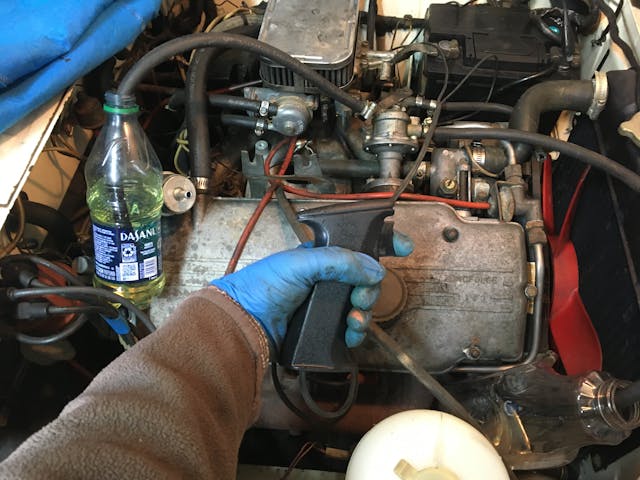
On a fuel-injected car, care must be taken because the fuel pressures are much higher, but depending on the age of the car, you may still be able to disconnect the fuel line from the fuel rail, energize the fuel pump by cranking the engine, and verify that fuel is squirting out. At some point, though, most fuel-injected cars switched over from simple rubber hoses and hose clamps to dedicated fittings with crimp-on connectors, and instead of putting the hose end in a bottle, it may be necessary to use a fuel pressure gauge with the proper fitting to screw into the test port on the fuel rail. If there’s no pressure, then the fuel pump isn’t running. The problem could be in the pump or the relay that controls it. An enthusiast forum will usually have information on the location of the relay, enabling you to jumper over it (connect pin 30 to pin 87). If that doesn’t bring things to life, the fuel pump itself probably needs to be replaced or at least troubleshot to see if an in-tank hose has fallen off it.
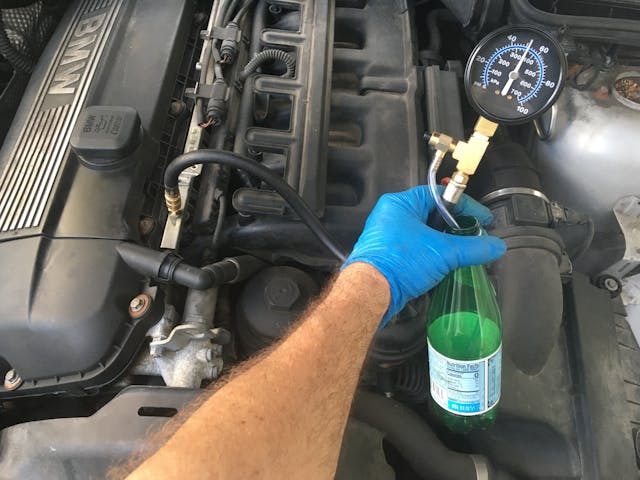
If temperatures are cold and the engine cranks and has both gas and spark but it still won’t start, it’s likely an issue in the cold-start circuit. On a carburetor, this is the choke. The choke plates should rotate closed over the top of the carb, and the carb linkage should settle on the fast-idle cam so the throttle plates are partially open. On a primitive electronically fuel-injected car, there’s usually a cold-start injector in the throttle body that opens up to squirt fuel while the engine is cranking and for some short amount of time afterward. For troubleshooting reasons, it’s fairly common practice to either wire these to a little push-button switch or to connect them directly to the starter solenoid so you know they’re receiving voltage during cranking.
There, that’s most of it.
But don’t message me saying “HELP! My car won’t start!” I hate that. If I can train my wife and kids, I can train you.
***
Check out the Hagerty Media homepage so you don’t miss a single story, or better yet, bookmark it. To get our best stories delivered right to your inbox, subscribe to our newsletters.


Rob very insightful article today give the season and the cold temperatures. A public service as most mechanics today have never seen a car equipped with points and condenser. So your article could be utilized as a learning tool. Also I might add that the early EFI systems from Bendix utilized two fuel pumps (in line and in tank) and that the power source for both pumps was routed through the ECU and as the pumps aged they drew more power which in turn created excess heat in the ECU and would burn out the motherboard which can cause a no start condition (well like no run condition as if the motherboard burnt out while driving the car would stop running right now). Again very insightful article.
One most common issue with a Starter is it is just bad. It may have warped armature or solenoid that is bad. Often a small rap of a hammer on the side will get it to start and get you home to replace it.
I worked at a gas station surrounded by bars, We used to get the beer trucks doing a delivery near by often. Hot and cold weather these starters would fail. I would often just help out with a hammer rap and get them on their way.
I used to get a lot of free beer that way as I do not drink. But it made my buddies happy.
I had forgotten the tap-the-starter trick. Thanks.
I wore down my battery on my 84 Mustang as I had something plugged into the “cigarette” lighter and did not drive the car for a few days, went to start “click, click”, duh. All my other cars the electronic power receptacle, to be correct are not powered all the time only when switched to acc or start. Guess they figured most people do not smoke anymore and do not need to light up when the car is turned off unless they are in the backseat in that case use a lighter.
speaking of battery life, 11 years ago I installed an Optima Red Top battery in my classic car. it is a driver and puts on about 4,000 miles a year. While in my garage I always attach a battery tender to ensure the battery is charged. Wonder if this gel cell type battery, the battery tender, or both has contributed to the long battery life. Still going strong with no issues
Ditto! That’s my setup as well. Optima Red Top and a Batter Tender (not a trickle charger).
Great article. In 1970, I bought a 1968 , 124 Fiat Spider and the car ran great for about a year then started having start problems. Sometimes it would start right up , other times it would just “click” like a week battery. Since I had no idea how old the battery was, I just replaced the battery, but the problem continue. I bought a rebuilt starter, jacked the front end up on the Fiat, crawled under and found the ground wire to the starter just hanging there , not connected to the block of the engine. I was lucky as the bolt was still in the end of the ground strap, took about five minutes to reattach it to the block. Starter Worked as should , Sold the Fiat about 6 years later & the starter worked every time.
Wow! Excellent tutorial. You nailed it.
Thanks Bob!
I only recently discovered the Volt Meters that plug into a cigarette lighter outlet. They may not be the most accurate devices, but good enough for basic trouble shooting. These are extremely convenient. No need to go out and lift the hood in -25 F temps, or fumble under the car in the snow. All you do is pause for a moment when turning the ignition key to verify the open circuit voltage of the battery is in the 12.2 to 12.6 range, then continue to turn the key to start the car. Once the car is running, verify that it reads in the 13.5 to 14.5 ish range (telling you your charging system is running ok).
If you train yourself to do this every time you start the car (it literally only take a few seconds), you dramatically cut down on the chances you will be surprised or stranded due to battery/charging issues.
This device won’t necessarily show you problems of the loose or corroded battery terminal type, but at about 10-15$ still well worth it. Great stocking stuffer at Christmas. Excellent gift for non car types like girlfriends and wives. And when they call you for help they’ve got a tool that allows them to help you trouble shoot the issue remotely.
I never leave home without mine.
Yes, completely agree, have extolled the virtues of cig-lighter voltmeters in several other pieces.
Another trick – which I learned on BMWs, but applies to pretty much any EFI car with an in-tank pump – is to whack the tank with a big rubber mallet. Obviously after battery & starter prove OK, the engine cranks, but won’t light off. Sounds Neanderthal, but I’ve persuaded several pumps to wake up & get folks home. Usually with a good laugh, which can also be important.
1) For checking fuel flow, I would just loosen the banjo bolt on the cold start injector and do a half second crank. If it’s still dry the problem is between the engine and the gas tank.
2) Some cars have fuel pump check connectors. Jumper the 2 pins together to get the pump running as cars have fuel pump shut down built in (If the engine isn’t running, the fuel pump stops.
3) Had to change the starter on my Solara V6. It’s on top of the transmission under the air box. Thank you Toyota.
#3: Be thankful, some Toyotas engines and the started INSIDE the engine under the intake manifold.
On certain era Fords you remove the octane adjust jumper and plug it into the fuel prime connector and the pump will run until you pull it back out. Nice easy way to check the fuel system. With many newer cars you can use a scan tool to turn on the fuel pump circuit.
First thing we were taught in auto shop for a “no crank”, before whipping out tools or even popping the hood, was to turn on the headlights to see if there was juice in the battery. Or stepping on the brakes to see if there were brake lights or turning on the hazards.
Regarding the points ignition… Check to see if there’s twelve volts to the coil when cranking. That lead comes from the starter and is “excited” when you crank it over. If the engine runs (lest I say motor and set off a firestorm) while cranking but stops running when key is released to the “on/run” position, then the “key hot” lead/circuit, which may have a ballast resistor as well, needs to be checked. I bought a 620 Datsun pickup that had some alarm system wired in and summarily cut out with prejudice and it ran in the cranking position and would die when key was released to “on/run”. To quickly get it home, I found a circuit that was “key hot”, ran a wire from there to the coil and drove it onto the trailer. Needless to say I already paid the guy for his “not running” truck before I fixed it. Yeah, I’m that guy…
All modern cars have an electric fuel pump. First thing I would check is the fuse. My F 150 parked would turn over but no fire. Turned out to be the fuel pump fuse. Replaced and no problem since. Why did it pop? could not find a reason but always have fuses in the glove compartment just in case. Is there gas in the tank? Some people, some very close to me tend to get gas past when the light comes on. To me, when there is 1/4 of a tank I consider it empty, also keeps the fuel pump from overheating.
Was working in the base’s auto hobby shop. Guy in the next bay was bumping over his engine using the screwdriver trick. He had just finished some painting in the engine compartment. There’s a reason there are multiple fire extinguishers in those hobby shops.
Great article. Battery issues have been 99% of my issues once they got old or drained completely. I’ve had one alternator issue, no starters so far.
Yeah, the ballast resistor has gotten me before as well, easy to bypass. One warning to add when jumping the starter-you bypass all sorts of safety devices when doing this- make sure that it is not in gear!
We had a 67 galaxy that had been stolen and the underdash wiring was hacked. While troubleshooting it, I had a lapful of wires and it was not cranking. I noticed the neutral start switch hanging in the air, and moved it to simulate the park position. The car started, but I had the (automatic column) shift lever down to pull the cluster. Of course there was a second or so delay and then the car lurched forward, heading for some bushes (thankfully). When I grabbed the steering wheel, it came off in my hand almost comically. I stopped the car and just laughed.
Yup. Neutral/park safety switch on a GM column, clutch in switch for the manual trans cars. All that would also cause a “no crank”.
Not sure if this is off-topic, but I had a 68 Impala convertible that after driving for some time, would stop running. Then after sitting for a bit, it would crank, fire and drive and then stop after running for awhile. Went through all the basic ICE basics of fuel, air and spark diags. Nothing popped up. So, after some thinking I reached under the dash and grabbed the connector for the ignition switch. It was hot. I had replaced the ignition switch and when I popped the connector back on, the main hot (the big pink for you GM folks) wasn’t seated on the the spade connector on the switch. It was trapped between the connector housing and the spade connector on the ignition switch. The connector would heat up from the crappy “connection” and due to the heat, the connector would get soft and the “connection” would be lost. I reseated the the connector making sure all the connections were solid on their respective spade connectors and never had another issue.